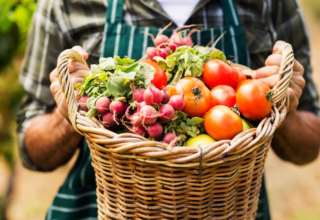Kale – sorry, but that’s so last year. It’s cauliflower that is currently reigning supreme as the vegetable du jour, the ingredient that all the clean living hipsters and bloggers jostling for attention on Instagram seem to subsist on.
 Cauliflower is no longer just a humble cruciferous vegetable. A member of the broccoli family it has come a long way from the days when it was boiled to a soggy death and then drowned in lumpy cheese sauce.
Cauliflower is no longer just a humble cruciferous vegetable. A member of the broccoli family it has come a long way from the days when it was boiled to a soggy death and then drowned in lumpy cheese sauce.
It’s now the go-to veggie of choice for lifestyle and health bloggers who as a breed typically shun carbohydrates in all its forms.
Unlike kale, which not everyone can stomach because of its bitterness, cauliflower is a versatile veg which is being embraced by food bloggers and chefs alike.
Cauliflower doesn’t only come in white varieties, there are also purple and yellow types, and chefs are becoming increasingly inventive when it comes to cooking them.
Because cauliflower has a relatively low water content, it also makes it much more suitable for successful caramelising, pureeing, mashing and baking. We are now using it in pizzas and pilafs, roasted whole or spiced and with Middle Eastern flavours to boot.
Healthy boost
 Another appeal of cauliflower is the fact that it’s packed with health giving nutrients. It is a great source of vitamin C, with a 125 g serving providing nearly three quarters of our recommended daily intake. It’s also full of fibre, which helps maintain a healthy gut, vitamins B6 and K, omega 3’s and manganese.
Another appeal of cauliflower is the fact that it’s packed with health giving nutrients. It is a great source of vitamin C, with a 125 g serving providing nearly three quarters of our recommended daily intake. It’s also full of fibre, which helps maintain a healthy gut, vitamins B6 and K, omega 3’s and manganese.
Even better is orange cauliflower, which contains 25% more vitamin A than white cauliflower, while the green version (also known as broccolower), packs more protein.
The purple variant, meanwhile, is high in antioxidants and point romanesto, which resembles an alien cactus has more fibre and a nuttier taste and crunch.
Rice or potato substitute
Cauliflower can be shredded and used as a rice substitute, or mashed and served au gratin instead of mashed potatoes. It can even be crushed into a gluten free pizza crust.
It’s not only much lower in carbohydrates than pasta, potatoes or rice, but it has a whole host of other health benefits too.
Of course, the ongoing rise of vegetarianism and veganism has helped increase interest in all types of vegetables and not just cauliflower, but its sheer versatility makes it extremely appealing.
And the ongoing low carb craze and the popularity of the Paleo (meat, meat and more meat) and gluten free diets are also responsible for the vegetable’s culinary renaissance.
Cauliflower can also be baked with only a smattering of seasoning and oil, only for it to emerge from the oven moist and light and transformed into a mouth-watering dish.
Ideal for the BBQ
 And it’s not just health obsessive’s who are getting on board with the cauliflower trend. In the UK, leading supermarket Tesco has recently started selling a range of marinated “cauliflower steaks” which can be popped on the barbecue alongside the sausages and steaks, and appeal to mainstream consumers, not just at the leading edge of trendy eating.
And it’s not just health obsessive’s who are getting on board with the cauliflower trend. In the UK, leading supermarket Tesco has recently started selling a range of marinated “cauliflower steaks” which can be popped on the barbecue alongside the sausages and steaks, and appeal to mainstream consumers, not just at the leading edge of trendy eating.
But you can easily do this yourself at home by slicing a cauliflower head into steaks, and steaming it first to tenderise it before dusting it with flour and chilli powder and then frying till golden brown.
Cauliflower is also good pureed as a tasty side dish with many meats, or whipped up into a quick and delicious soup.
Given its versatility it seems the humble cauliflower is set for vegetable stardom for some time to come.







